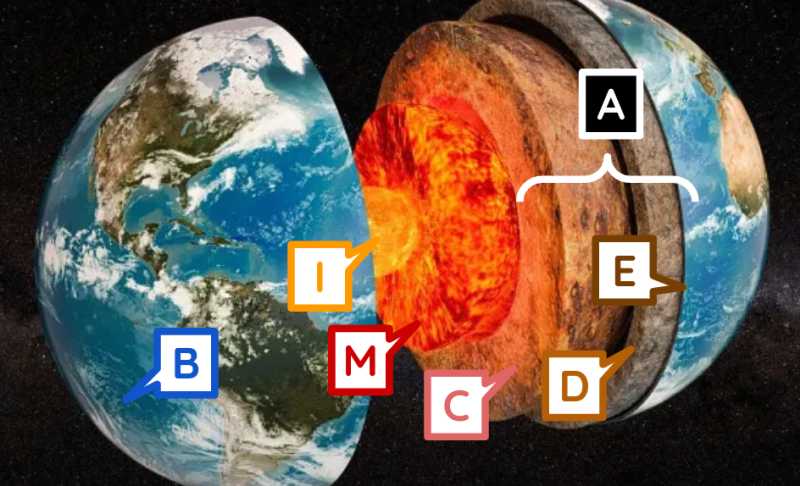The 3 Kinds of Terrestrial Particles
Table of Contents
32. How the upper region of the Earth was first divided into 2 different bodies.
The Earth is now approaching the vicinity of the Sun.
Its upper region consists of earth-aether particles that are not firmly connected.
- These mingle with air-aether globules smaller than those found in the gravitational territory that it passes through or even in the one it will head into.
- These smaller globules rush with force toward the earth-aether particles and impact them.
With the help of the force of gravity, they displace the denser ones below. This creates irregular and varied structures that bind more tightly among themselves than the upper ones.
This interrupts the motion of air-aether globules.
This results in the upper region of the Earth, as shown here towards A, being divided into 2 vastly different bodies, as shown towards B and C.
Babove is decompressed, fluid, and transparentCbelow is somewhat dense, hard, and opaque.

I is the innter core, M is the outer core, C is the lower mantle, D is the upper mantle, E is the crust,33. The 3 Kinds of Terrestrial Particles
Body C is different from Body B solely because its particles adhered to each other after being pressed downwards by the air-aether globules.
Body D is generated between these two.
The shapes of the earth-aether particles constituting bodies B and C are quite varied.
These can be classified into 3 main types:
- The branched ones
These are divided into various branches, extending here and there like the branches of trees.
These are primarily the ones expelled downward by the air-aether and adhere to each other, composing body C.
- The more solid ones
They have shapes of spheres or cubes but also angular fragments of any kind.
- If these are larger, they descend below others under the force of gravity.
- If they are smaller, they remain mixed with the larger ones and fill the gaps left by them.
- The oblong or elongated ones
These are devoid of branches, like rods. These also intersperse among the others, finding ample gaps between them, but do not easily connect with them.
34. How Body D was formed between Body B and C
When the particulate branches of body C began to intertwine with each other, many of them were oblong in shape and inserted in between them.
Later, as these branching structures became more and more tightly intertwined. They gradually ascended above them towards D where they were collected, forming a body significantly different from both B and C.
This is similar to how water is pressed out of marshy places when we walk on the ground which then covers the surface.
In the meantime, several particles from body B have slipped away, increasing the mass of the two lower bodies C and D.
35. Only particles of one kind are contained in Body D
Initially, the following were inserted among the branching ones:
- the oblong particles
- the particle fragments of solid stones
- These more solid ones did not ascend as easily above the branching ones, as did the oblong ones.
- If they did, they more easily descended back below the oblong ones afterwards.
- This is because the oblong ones, all else being equal, have more surface area in relation to their mass.
The oblong ones, given equal circumstances, have more surface area in relation to their mass.
Therefore, as the air-aether matter flows through the body C, they are more easily expelled.
After reaching D, they lie transversely on the surface of this body.
- They do not easily encounter pathways through which they can return to
C.
36. There are only 2 kinds of these particles in Body D.
Thus, many oblong [elongated] particles of the earth-aether were congregated towards D.
Initially, they were not perfectly equal or similar.
But they both could not easily adhere to each other or to other earth-aether particles.
- This was because they were moved by the surrounding air-aether flowing around them.
Due to this property, they departed from body C and were collected in D.
The air-aether flows continuously around them there, causing them to:
- move in various ways
- migrate from one location to another
Over time, they become smooth and cylindrical, nearly equal in size, reducing them to only two kinds.
- The thin flexible ones
These bend under the sole force acting on them by the air-aether. These could bend around others and gradually became more flexible over time, resembling eels or short ropes.
- The inflexible ones
These are slightly thicker and cannot bend. These gradually lost their flexibility and remained rigid like spears or arrows.
The flexible ones revolve around them.
These two species joined together more easily and persisted in their motion more readily than either the flexible alone or the inflexible alone could.
Therefore, both remained in body D.